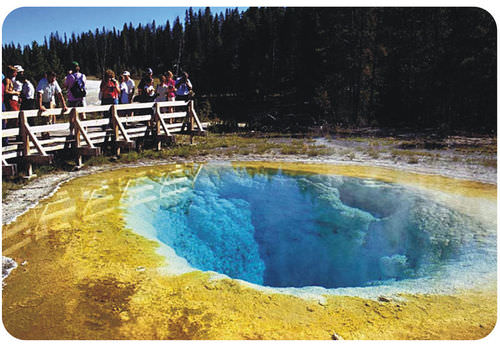7.5 细菌生境
章节大纲
-
Where do you find lots of bacteria?
::你在哪里找到很多细菌?Practically all surfaces. can live and grow in practically any environment. It is this ability that has made bacteria the most numerous on the planet.
::几乎所有表面都能在任何环境中生存和生长。正是这种能力使细菌成为地球上数量最多的细菌。Prokaryote Habitats
::普罗卡里奥特生境have a wide range of metabolisms, and this determines where they live. They live in a particular habitat because they are able to “eat” whatever is around them. For example, there are bacteria and that break down hydrogen sulfide to produce ATP . Hydrogen sulfide is the gas that gives rotten eggs and sewage their distinctive smell . It is poisonous to , but some prokaryotes depend on it for life.
::新陈代谢种类繁多,这决定了他们居住的地方。他们生活在一个特定的生境中,因为他们能够“吃”周围的东西。例如,有细菌,分解硫化氢以产生ATP。硫化氢是给腐烂的卵子带来腐烂的气息并排出他们特有的气味的气体。它有毒,但有些prokaryotes终生依赖它。Organisms that are obligate aerobes need oxygen to live. That is, they use oxygen as a terminal electron acceptor while making ATP (see the “Cellular Respiration” concept). Humans are obligate aerobes, and so are Mycobacterium tuberculosis bacteria. M. tuberculosis causes tuberculosis (TB). Obligate aerobes are found only in places with molecular oxygen.
::强制抗生素的生物体需要氧来生存。 也就是说,它们使用氧作为终端电子接收器,同时制造ATP(见“细胞呼吸”概念 ) 。 人类是强制性激素,而M. 肺结核细菌也是如此。 M. 肺结核导致肺结核。 强制性激素只有在分子氧的地方才会被发现。An anaerobic organism is any organism that does not need oxygen for growth and even dies in its presence. Obligate anaerobes will die when exposed to atmospheric levels of oxygen. Clostridium perfringens bacteria, which are commonly found in soil around the world, are obligate anaerobes. Infection of a wound by C. perfringens bacteria causes the disease gas gangrene. Obligate anaerobes use molecules other than oxygen as terminal electron acceptors.
::无氧有机体是不需要氧来生长、甚至在其存在时死亡的任何有机体,在接触大气氧气水平时,有义务的厌食动物会死亡;在世界各地土壤中常见的环斑菌细菌是强制性的厌食动物。C. 过敏细菌的伤口造成疾病气坏疽。强制厌食动物使用除氧以外的分子作为终端电子接收器。Facultative anaerobic organisms, which are usually prokaryotic, make ATP by aerobic respiration , if oxygen is present, but can also survive without oxygen. In the absence of oxygen they switch to the process of to make ATP. Fermentation is a type of heterotrophic metabolism that uses organic carbon instead of oxygen as a terminal electron acceptor. Examples of facultative anaerobic bacteria are the Staphylococci , Escherichia coli , Corynebacterium , and Listeria species. Many bacteria that cause human diseases are facultative anaerobic organisms.
::亚丁亚丁亚丁亚丁亚丁亚丁亚丁亚丁亚丁亚丁亚丁亚丁亚丁亚丁亚丁亚丁亚丁亚丁亚丁亚丁亚丁亚丁亚丁亚丁亚丁亚丁亚丁亚丁亚丁亚丁亚丁亚丁亚丁亚丁亚丁亚丁亚丁亚丁亚丁亚丁亚丁亚丁亚丁亚丁亚丁亚丁亚丁亚丁亚丁亚丁亚丁亚丁亚丁亚丁亚丁亚丁亚丁亚丁亚丁亚丁亚丁亚丁亚丁亚丁亚丁亚丁亚丁亚丁亚丁亚丁亚丁亚丁亚丁亚丁亚丁亚丁亚丁亚丁亚丁亚丁亚丁亚丁亚丁亚丁亚丁亚丁亚丁亚丁亚丁亚丁亚丁亚丁亚丁亚丁亚丁亚丁亚丁亚丁亚丁亚丁亚氧亚丁亚丁亚丁亚丁亚丁亚丁亚丁亚丁亚丁亚丁亚丁亚丁亚丁亚丁亚丁亚丁亚丁亚丁亚丁亚丁亚丁亚丁亚丁亚丁亚丁亚丁亚丁亚丁亚丁亚丁亚丁亚丁亚丁亚丁亚丁亚丁亚丁亚丁亚丁亚丁亚丁亚丁亚丁亚丁亚丁亚丁亚丁亚丁亚丁亚丁氧亚丁亚丁亚丁氧亚丁氧亚丁氧亚丁亚丁亚丁亚丁亚丁亚丁亚丁氧亚丁亚丁亚丁亚丁亚丁亚丁亚丁亚丁氧亚丁亚丁亚丁基亚丁基亚丁氧亚丁基亚丁基亚丁基亚丁基亚丁基亚丁基亚丁基亚丁基亚丁基亚丁基亚丁基亚丁基亚丁基亚丁基亚丁基亚丁基亚丁基亚丁基亚丁基亚丁基亚丁基亚丁基亚丁基亚丁基亚丁基亚丁基亚丁基亚丁基亚丁基亚丁基亚丁基亚丁基亚丁基亚丁基亚丁基亚丁二氧亚丁亚丁亚丁基亚丁基亚丁基亚丁基亚丁基亚丁基亚丁亚丁亚丁亚丁亚丁亚丁亚丁亚丁亚Temperature
::温度Like most organisms, prokaryotes live and grow best within certain temperature ranges. Prokaryotes can be classified by their temperature preferences, as shown in the Table . Which type of prokaryote would you expect to find inside the ?
::与大多数生物一样,prokaryotes在一定的温度范围内生存和成长最好。 Prokaryotes可以按其温度偏好进行分类,如表所示。 您期望在表内找到哪种prokaryote ?Thermophiles live at relatively high temperatures, above 45°C (113°F). Thermophiles are found in geothermally heated regions of the Earth, such as hot springs like the Morning Glory pool in Yellowstone National Park (see Figure ), and deep sea hydrothermal vents. Some thermophiles live in decaying plant matter such as peat bogs and compost. Many thermophiles are archaea. Extreme thermophiles (or hyperthermophiles ), live in temperatures hotter than 80°C (176°F).
::热极存在于地热热地区,如黄石公园的晨光池等温泉(见图)和深海热液喷口,有些热极生活在腐烂的植物物质中,如泥炭沼和堆肥。许多热极都是古代。极端热极(或超热极),温度高于80°C(176°F)。Psychrophiles grow and reproduce in cold temperatures. The optimal growth temperature of some psychrophiles is 15°C or lower; they cannot grow in temperatures above 20°C. The environments that psychrophiles inhabit are found all over Earth. Psychrophiles live in such places as permafrost soils, deep-ocean waters, and Antarctic glaciers and snowfields.
::某些精神病人的最佳生长温度为15摄氏度或更低;在温度高于20摄氏度的温度中不能生长。 精神病人居住的环境遍布全球。 精神病人生活在永久冻土、深海水域、南极冰川和雪地等地方。Mesophiles grow best in moderate temperature, typically between 20°C and 45°C (68°F and 113°F). Mesophiles are often found living in or on the bodies of humans or other animals. The optimal growth temperature of many pathogenic mesophiles is 37°C (98°F), the normal human body temperature. Mesophilic organisms have important uses in food preparation, including cheese, yogurt, beer and wine.
::中度温度的中度药剂生长最佳,通常介于20°C至45°C(68°F和113°F)之间,常发现中度药剂存在于人类或其他动物的体内或体内,许多病原体药剂的最佳生长温度为37°C(98°F),这是人体的正常体温,中度生物在食品制作方面有重要用途,包括奶酪、酸奶、啤酒和葡萄酒。Type of Prokaryote Preferred Temperature Where It Might Be Found Thermophile above 45°C (113°F) in compost Mesophile about 37°C (98°F) inside animals Psychrophile below 20°C (68°F) in the deep ocean The Morning Glory pool of Yellowstone National Park in the United States is a geothermal pool whose waters are heated to high temperatures by magma deep underground. Hyperthermophilic organisms, such as members of the archaeal genus Sulfolobus can live at temperatures between 60°C-80°C and a pH of 3. Summary
::摘要-
Aerobic prokaryotes live in habitats with oxygen.
::有氧原虫生活在有氧的生境中。 -
Anaerobic prokaryotes live in habitats without oxygen.
::厌氧原虫生活在没有氧气的生境中。 -
Prokaryotes may also be adapted to habitats that are hot, moderate, or cold in temperature.
::Prokaryotes还可能适应热、中度或温度寒冷的生境。
Review
::回顾-
Why are many prokaryotes adapted for living at the normal internal temperature of the human body.
::为什么许多原虫会适应 在人体正常的内温下生活? -
Compare psychrophiles to thermophiles.
::比较精神错乱 与嗜血药。 -
Compare obligate aerobes to facultative anaerobes.
::比较起来 强迫厌食 与习惯性厌食。
-
Aerobic prokaryotes live in habitats with oxygen.

